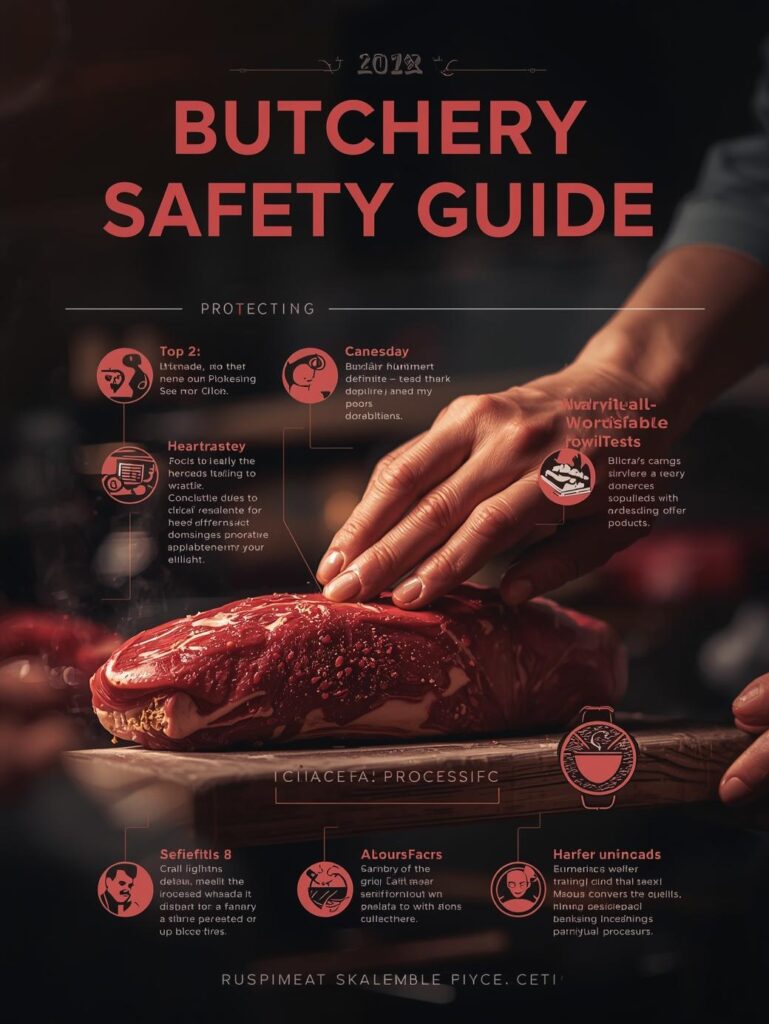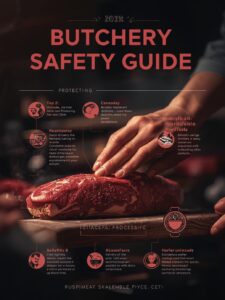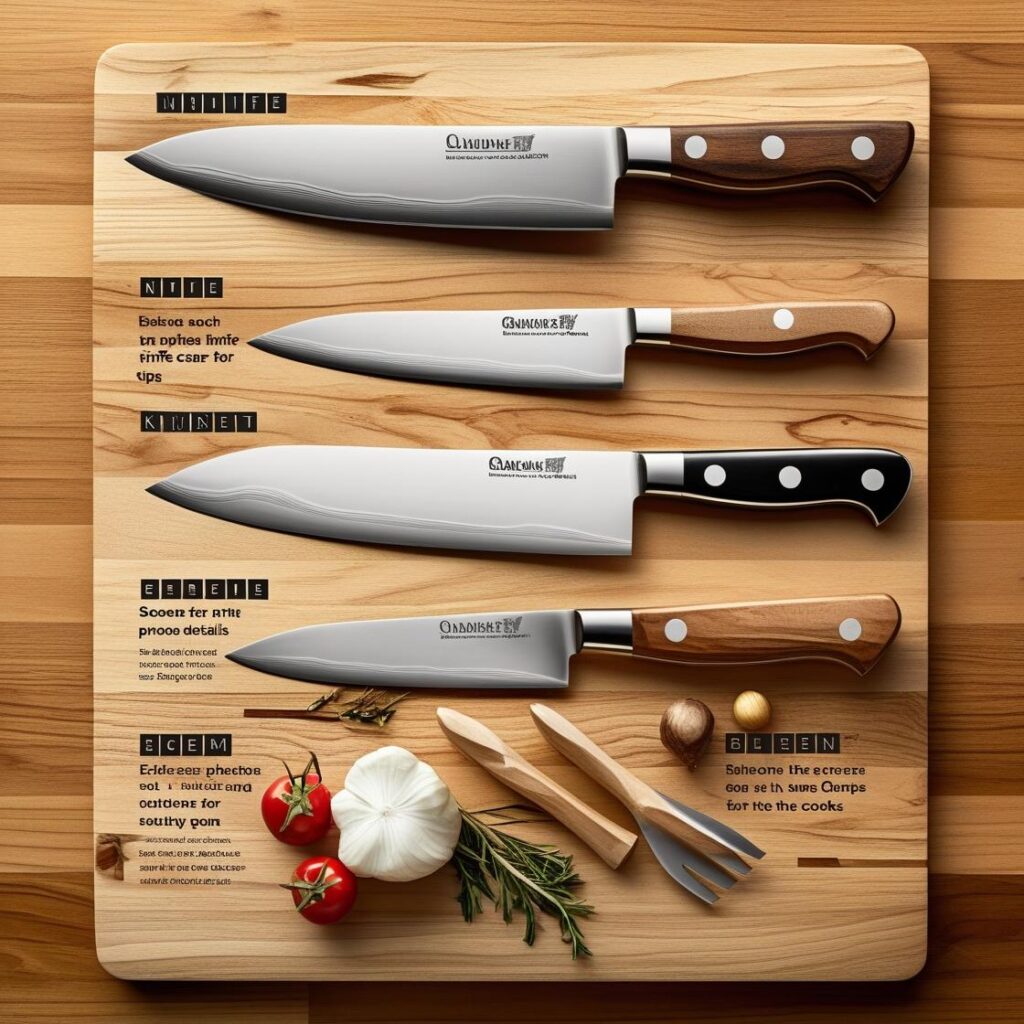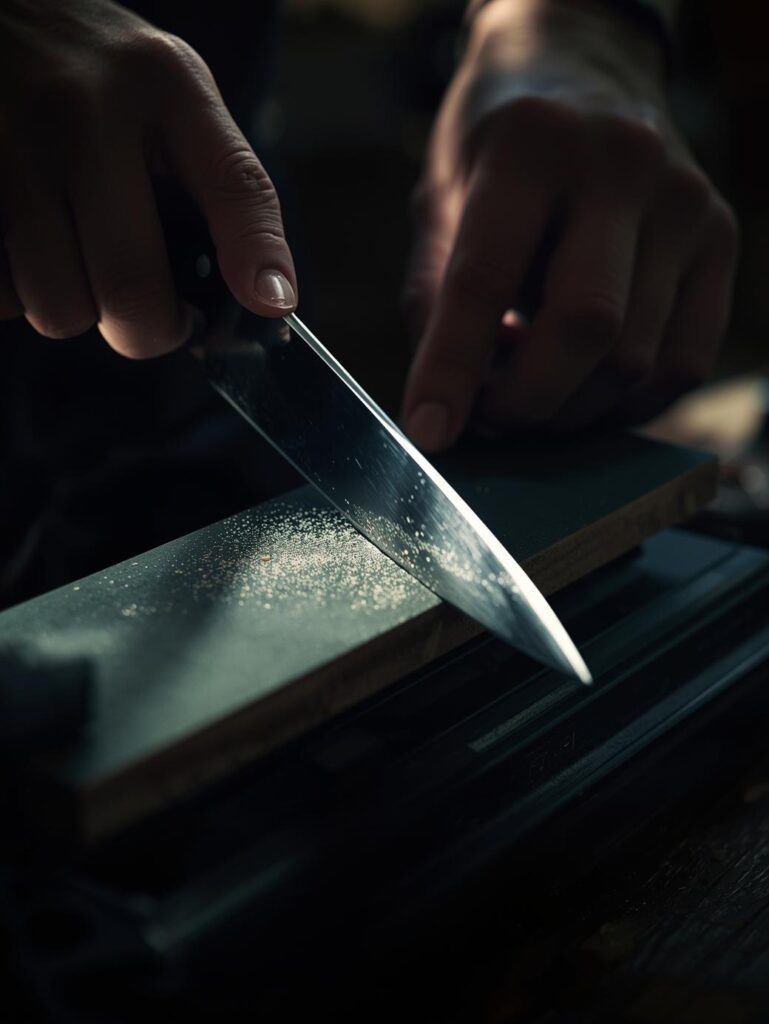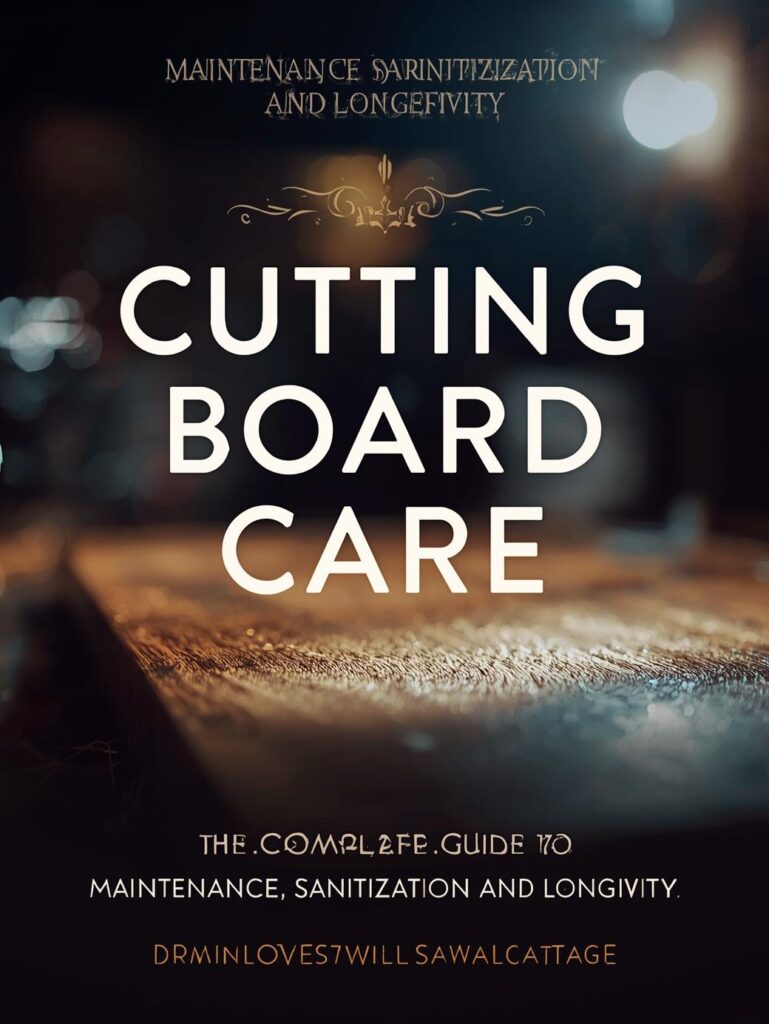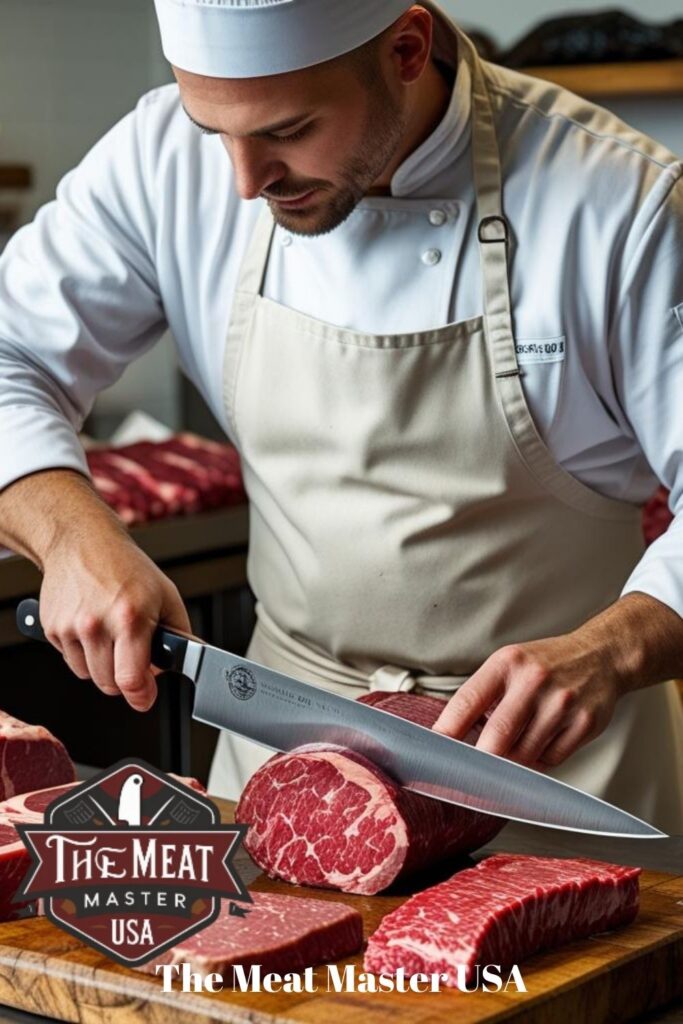Aussie Expert’s Note: This guide anchors our professional butchery foundation series. Safety in meat processing isn’t about fear—it’s about respect. Respect for the tools, the materials, and the process. The most dangerous moment in any butcher’s career isn’t their first cut; it’s when they become complacent. This guide builds the unshakable habits that separate professionals from amateurs and keep fingers attached where they belong.
Butchery Safety Guide: Essential Protocols for Safe Meat Processing at Every Level
“Butchery safety isn’t a set of rules to follow—it’s a mindset to embody. It’s the understanding that every piece of steel has an appetite, every surface a potential for contamination, and every moment of distraction a consequence. The best butchers aren’t the fastest or strongest; they’re the most aware. They move with intention, cut with purpose, and maintain a vigilance that becomes as natural as breathing.”
Butchery Safety Guide: Essential Protocols for Safe Meat Processing at Every Level
Download the Butcher's Safety Checklist - PPE, Protocols & Emergency Response
Butchery transforms primal cuts into culinary masterpieces, but it demands absolute respect for the tools, techniques, and potential hazards involved. Whether you’re breaking down a side of beef in a commercial facility or preparing a single roast at home, safety isn’t just about avoiding cuts—it’s about creating a systematic approach that prevents accidents before they happen. This guide builds the foundation that keeps professionals cutting for decades and home cooks confident in their kitchen.
🎯 THE SAFETY PHILOSOPHY: MINDFULNESS OVER MUSCLE
Safety begins between your ears before it ever reaches your hands.
⚙️ The Four Pillars of Butchery Safety
Where Awareness Meets Action
- Respect for Sharp Edges: Every blade has one purpose: to cut. Respect that reality with every movement. A sharp knife is predictable; a dull knife is dangerous. A focused butcher is safe; a distracted one is a liability.
- Control Through Positioning: Your body position dictates your safety. Stable stance, clear sight lines, and planned cutting paths prevent slips and misplaced cuts. Proper positioning makes accidents nearly impossible.
- Cleanliness as Protection: A clean workspace isn’t just about organization—it’s your first defense against cross-contamination and slips. Blood, fat, and water create the perfect storm for accidents.
- Equipment Awareness: Know your tools’ capabilities and limitations. A bandsaw demands different respect than a boning knife. Power equipment requires different protocols than hand tools. Mastery includes understanding dangers.
🎯 Professional vs. Home Kitchen Safety
👨🍳 PROFESSIONAL STANDARDS
- Full PPE required
- Color-coded equipment
- Documented protocols
- Regular safety audits
- Emergency response plans
- Team accountability
🏠 HOME KITCHEN ADAPTATIONS
- Cut-resistant glove
- Separate cutting boards
- Clear work area
- First aid accessible
- Family awareness
- Proper storage
🔪 THE SAFETY LEXICON: SPEAKING PROTECTION
Master the language of safety before you master the cut.
🗣️ Essential Butchery Safety Terminology
From PPE to Cutting Paths
- PPE (Personal Protective Equipment): Your second skin. Cut-resistant gloves, anti-slip shoes, aprons, safety glasses. Not optional—essential.
- Cutting Path: The planned trajectory of every cut. Always away from your body, never toward fingers or palms. Visualize before executing.
- Pinch Grip vs. Claw Grip: Pinch grip controls the knife, claw grip protects the guiding hand. Master both simultaneously.
- Kickback (Bandsaw): When the saw blade catches and throws material backward. Always use push sticks, never hands near the blade path.
- Cut-Resistant Levels: ANSI ratings from A1 (lightest) to A9 (heaviest). Level A3-A5 ideal for butcher work. Know your protection level.
- Cold Zone vs. Hot Zone: Cold zones for handling, hot zones for cutting. Maintain separation and awareness of what happens where.
- Blade Awareness: Constant knowledge of where your blade is, where it’s going, and what’s in its path. The cornerstone of safety.
📊 The Ultimate Butchery Safety Matrix
🎯 Safety Protocols by Task & Risk Level
| Task | Primary Risks | Essential PPE | Critical Protocols | Skill Level |
|---|---|---|---|---|
| Hand Boning | Cuts, punctures, slips | Cut-resistant glove, apron | Claw grip, away cuts, sharp blade | Intermediate+ |
| Bandsaw Operation | Kickback, amputation | Chainmail, glasses, no gloves | Push sticks, two-hand operation | Expert Only |
| Grinder Use | Entanglement, contamination | No gloves, apron, hair net | Stomper only, guard in place | Intermediate+ |
| Slicer Operation | Lacerations, amputation | Cut-resistant, no loose clothing | Carriage return, off adjustments | Expert Only |
| Cleaver Work | Glancing blows, chips | Safety glasses, sturdy shoes | Clear area, predictable surface | Advanced |
| General Prep | Minor cuts, cross-contam | Cut-resistant, separate boards | Clean as you go, sharp knives | All Levels |
🔥 THE PPE ARSENAL: YOUR PERSONAL PROTECTION SYSTEM
Proper gear isn’t optional—it’s your first line of defense.
🎪 The Essential Protection Layers
Gearing Up for Battle
- Cut-Resistant Gloves (Level A3-A5): Your dominant hand’s best friend. Not slip-proof—still use proper technique. Test fit: should be snug but not restrictive. Replace at first sign of wear.
- Anti-Slip Shoes: More than just traction—closed toe, oil-resistant soles, and comfort for hours of standing. Your foundation literally and figuratively.
- Aprons (Rubber or Heavy Plastic): Easy-clean surface that fluids roll off. Not just for cleanliness—prevents slips from absorbed liquids and protects against accidental grazes.
- Safety Glasses: Bone fragments, metal from sharpeners, flying debris—your eyes are irreplaceable. Clear lenses for low-light areas, anti-fog for steamy environments.
- Arm Guards (Optional but Recommended): For large animal breakdown or beginners. Extra protection when learning muscle memory for new cuts.
- Chainmail (Power Equipment): Absolute requirement for bandsaws and slicers. Regular inspection for broken links—one compromised link compromises the whole garment.
🍖 THE KNIFE SAFETY PROTOCOLS: CUTTING WITH CONFIDENCE
Master your grip before you master your cut.
✋ The Two Essential Grips
Control & Protection in Harmony
- Pinch Grip (Knife Hand): Thumb and index finger pinch the blade just before the handle, other three fingers wrap the handle. Maximum control, minimum effort.
- Claw Grip (Guide Hand): Fingers curl inward, using knuckles as blade guide. Fingertips protected, consistent distance maintained. The guardian of your fingers.
- Practice Without Cutting: Dry runs build muscle memory. Practice both grips without meat until they feel natural and coordinated.
- Pressure Control: Let the sharp blade do the work. Heavy pressure causes slips. If you’re forcing, your blade is dull or technique is wrong.
🎯 The 10 Commandments of Knife Safety
Non-Negotiable Rules
- Always cut away from your body
- Keep knives sharp—dull blades slip
- Never try to catch a falling knife
- Carry knives point-down, blade-back
- Maintain focus—no distractions
- Use the right knife for each job
- Keep handles clean and dry
- Store properly—never loose in drawers
- Never leave knives in sinks
- Pass handle-first, announce transfer
🧂 THE WORKSPACE SANITATION: CLEANLINESS AS SAFETY
A clean workspace prevents both contamination and accidents.
🎯 The Color-Coded Defense System
Visual Safety at a Glance
- Red Everything: Raw red meat boards, knives, containers, handles. Instant visual recognition prevents cross-contamination.
- Yellow for Poultry: Raw chicken and turkey get their own dedicated color. Highest risk category gets exclusive tools.
- Blue for Seafood: Fish and shellfish separation. Different pathogens, different cleaning protocols.
- Green for Produce: Fruits and vegetables never touch meat equipment. Vegetarian safety and flavor protection.
- White for Dairy/Cooked: Ready-to-eat foods and dairy products. The “safe zone” equipment.
- Brown for Cooked Meats: Separate even cooked meats from raw preparation areas. Final safety barrier.
- Home Kitchen Adaptation: Minimum three boards: raw meat, produce, cooked foods. Different materials or marked edges.
📋 THE ULTIMATE SAFETY CHECKLIST TIMELINE
The Rhythm of Constant Vigilance
Pre-Work Inspection (5 min)
PPE check, equipment inspection, workspace clearance, first aid verification, mental focus.
Hourly Maintenance (2-3 min)
Surface sanitization, tool cleaning, floor check, hydration, focus assessment.
Task Transition (1-2 min)
Equipment change, surface cleaning, glove change if needed, mental reset.
Post-Work Protocol (10 min)
Full cleanup, equipment storage, damage reporting, incident documentation, restock.
🚨 EMERGENCY RESPONSE: WHEN PREVENTION FAILS
🎯 Immediate Response to Common Injuries
| Injury Type | Immediate Response | Medical Attention? | Prevention Focus |
|---|---|---|---|
| Minor Cut | Pressure, clean, bandage, glove | No (if superficial) | Claw grip, sharp blades |
| Deep Laceration | Elevate, pressure, seek help | YES (immediately) | Cutting path, focus |
| Puncture Wound | Let bleed, clean deeply, monitor | Yes (risk of infection) | Knife control, awareness |
| Slip/Fall | Assess injury, don’t move if back/neck | Yes (if head injury) | Clean as you go, proper shoes |
| Cross-Contamination | Discard affected food, deep clean | Yes (if illness develops) | Color coding, separation |
🏁 BUILDING UNSHAKABLE SAFETY HABITS
Butchery safety isn’t about memorizing rules—it’s about building habits so ingrained they become automatic. It’s the muscle memory that positions your hands correctly without thought, the spatial awareness that keeps your body out of cutting paths, and the vigilance that notices potential hazards before they become problems.
The true mark of a master butcher isn’t the complexity of their cuts or the speed of their work—it’s their impeccable safety record. They understand that every safety protocol, every piece of PPE, every careful movement is an investment in their ability to keep doing what they love for years to come.
Start building your safety foundation today. Practice your grips without cutting, organize your workspace with intention, and approach every tool with respect. Safety isn’t a limitation—it’s the framework that enables true craftsmanship.
Build your foundation with the right tools and techniques
Complete Your Butcher’s Education: Master all aspects of professional meat preparation.

